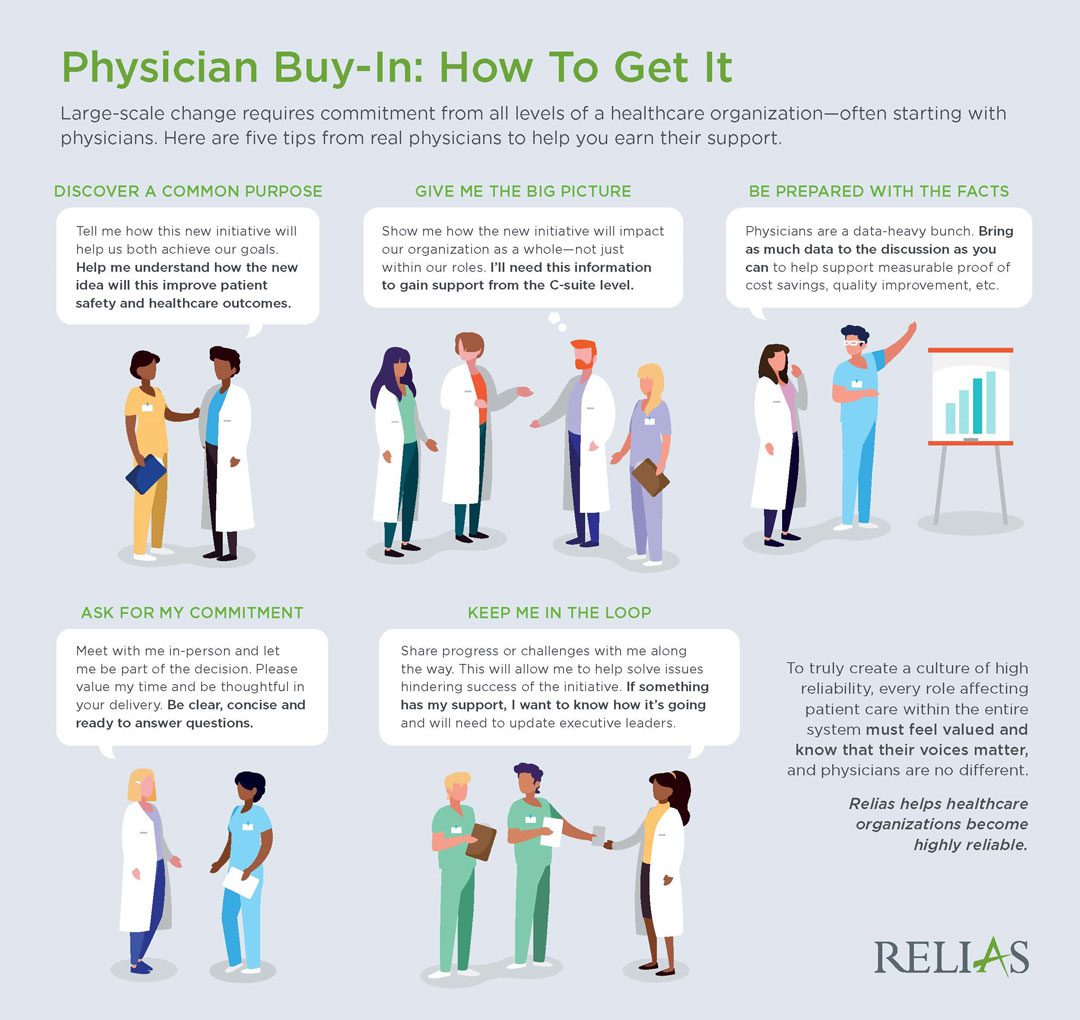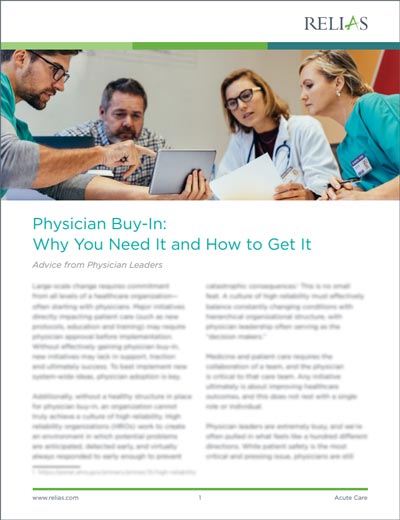It’s no secret that physicians are often perceived as the “top of the hierarchy chain” in healthcare, just as it’s no secret that obtaining their buy-in can be viewed as a roadblock by many nursing and healthcare leaders.
Without a healthy structure in place for physician buy-in, an organization cannot truly achieve a culture of high reliability. Medicine and patient care requires the collaboration of a team, and the physician is critical to that care team. Any initiative ultimately is about improving healthcare outcomes, and this does not rest with a single role or individual but is rather multidisciplinary.
To truly impact patient safety through large-scale change, physician support and adoption is usually a good place to start.
While patient safety is the most critical and pressing issue, physicians are still faced with a plethora of tasks and requirements on a regular basis (e.g., charting, billing, admin, re-credentialing, education), making it difficult to capture their time and attention in the first place.
Shared below are two perspectives on how to address these challenges and successfully gain physician buy-in.
Lora Sparkman, MHA, BSN, RN
Patient Safety and Quality Executive, Relias
As a nurse who’s led maternal safety improvement efforts at the nation’s largest nonprofit healthcare system, I understand firsthand the challenges that can come with gaining physician’s buy-in. Overall, I believe we need to change the current narrative around “physicians being resistant” and address this notion as “how can we enable physicians’ participation?”.
In my previous experience, and still in my current role—I continue to see a slightly negative perception across the country on physicians as unwilling to buy-in or get on board with new initiatives. A few ways I advise nursing and healthcare leaders to help flip the script on this perception is:
- Look at the culture: In a high reliability organization, commitment to patient safety must start at the top, with commitment following from all levels of healthcare workers.
- Engage physicians early on: Encourage physicians to be part of the decision-making process, and allow for conversation and shared collaboration on patient safety initiatives. Take time to listen to their hesitations or concerns if present.
- Never underestimate the power of nursing influence: Nurses are highly influential in turning the dial on improving patient safety and outcomes, and physician participation should never be a barrier that doesn’t allow nursing’s initiatives to move forward.
- Remember the common goal: At the end of the day, all providers want to do the “right thing.” It’s not a matter of “not doing the right thing for patients,” but rather, “how will we do the right thing for patients?”.
Every healthcare team member comes to work wanting to do the right thing for patients, and we can’t be afraid to move forward when met with a little pushback. By engaging with physicians and making it easier for everyone to do the right thing, (e.g., planning simulation and team training drills around physicians’ schedules) we’ll always see the best possible outcomes.
William Cusick, MD, MFM, FACOG
Chairperson of OB/GYN and Director of Maternal Fetal Medicine, St. Vincent’s Medical Center
At a high-level view, it’s critical to include physician leaders at the start of any initiative, through the development and implementation process—ultimately utilizing physician champions to promote the initiative’s adoption and spread. Providing supporting data and clearly outlining the desired outcome is key as well.
Speaking more specifically (from a physician’s perspective), I think it’s important to remember that physicians (like many of us in healthcare) are pulled in many directions, and administrative burdens can pull us away from time with patients. This is often an initial reluctance that some physicians might have with implementing new initiatives—will this just be “one more thing” I need to find time to accomplish?
Data certainly helps here—and if physicians see the value in something, they’ll most likely always be on board. Showing the “why” and “how” will clearly and quickly demonstrate the problem we’re looking to solve and how we’re going to do it. Available data demonstrating adverse outcomes is a great motivator for physicians to improve patient safety, whether it be data from our respective unit, department, or even our own patients.
With their limited time, physicians by nature want to focus on that from which they (and it turn, their patients) can derive benefit. If we’re able to share the knowledge and help physicians to see the case for a new initiative, they’re more likely to buy in.
In an environment where adverse events and emergencies occur, physicians understand that time is of the essence and the best and strongest argument for preparation is a team working collaboratively with the provider. Patient safety initiatives that are presented with a focus on developing a highly effective, well-functioning team will always speak to a physician’s head and heart.


Physician Buy-In: Why You Need It and How to Get It
Most patient safety initiatives (including new protocols, training and education) require physician approval prior to implementation. Without effectively gaining physician buy-in, new initiatives may lack in support, traction and ultimately success. Additionally, without a healthy structure in place for physician buy-in, an organization cannot truly achieve a culture of high reliability. To best implement new system-wide ideas, physician adoption is key.
Download White Paper →





